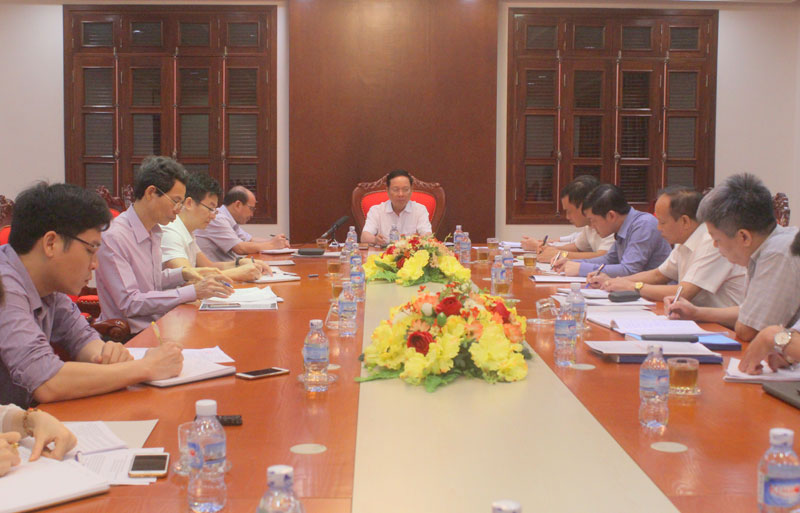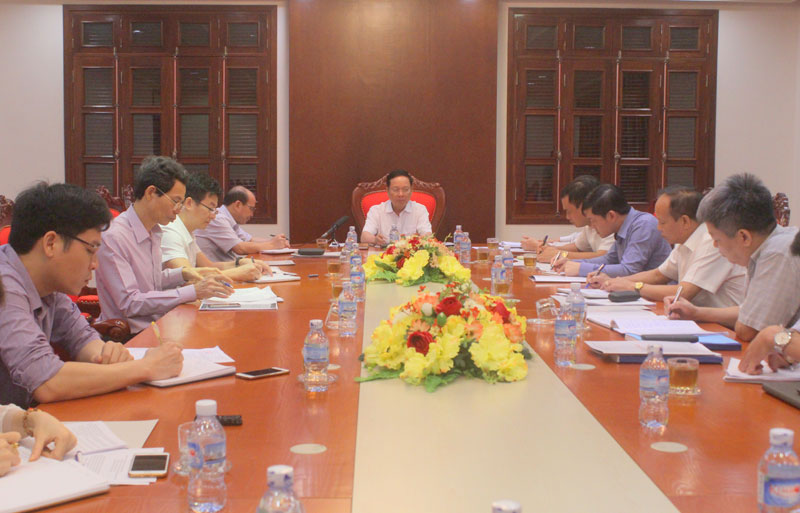
(HBO) - Bui Van Tinh, member of the Party Central Committee and Secretary of the Hoa Binh provincial Party Committee, chaired a working session on May 9 that discussed the realisation of the urbanisation target and the transparency of financial plans for local property projects.

Bui Van Tinh, member of the Party
Central Committee and Secretary of the Hoa Binh provincial Party Committee,
chairs the working session.
According to the provincial Department of
Construction, the urbanisation rate in Hoa Binh reached 18 percent in 2018,
lower than the regional and national averages. Meanwhile, the resolution of the
16th provincial Party Congress and urban development plans aim at 25 percent in
2020.
Regarding the transparency of financial plans
for property projects, 45 projects have had their investment procedures carried
out in line with the Housing Law, the Government’s Decree No. 99/2015/ND-CP,
and Decision No. 08/2017/QD-UBND of the provincial People’s Committee.
Speaking at the session, Secretary of the
provincial Party Committee Bui Van Tinh emphasised the need for strong
engagement and high political resolve of the whole political system to take
drastic actions and concrete solutions to raise the urbanisation rate. Detailed
targets should be set for authorities at all levels, and administration leaders
must be responsible for implementing urban development plans.
Basing on the province’s urban planning, local
authorities need to focus on re-organising administrative units and increase
the number of urban dwellers to about 50,000. They also need to review the
process for recognising Luong Son township
of Luong Son district as
a fourth-tier urban area, while completing the plan to seek the second-tier
city status for Hoa Binh city.
The official also asked authorities to mobilise
resources for the implementation of key property projects to help raise the
urbanisation rate./.
Hoa Binh province is undergoing a dynamic transformation amid Vietnam’s national digital transition. Building on Poliburo’s Resolution No. 57-NQ/TW on breakthroughs in science, technology, innovation, and national digital transformation, the province has rolled out a wide range of practical action plans. A standout initiative is the "Digital Literacy for All” movement, an effort to ensure that no one is left behind in the digital era.
Hoa Binh province is undergoing a dynamic transformation in the wake of the national digital transformation movement. Building on Resolution No. 57-NQ/TW of the Politburo on breakthroughs in science, technology, innovation, and national digital transformation, the province has implemented a wide range of practical action plans. A standout initiative is the "Digital Literacy for All” movement ambitious effort to ensure that no one is left behind in the digital age.
With a spirit of unity and proactive problem-solving, the Party Committee, the government and the people of Dong Lai Commune (Tan Lac District) have made great strides in implementing the resolutions of the 24th Party Congress of the commune for the 2020 - 2025 term. Focusing on leadership and practical actions, the commune has brought the Party’s resolutions into daily life, creating strong impacts and pushing the local development forward.
Amid the nationwide push for digital transformation, young people in Hoa Binh Province are stepping up as dynamic pioneers, applying technology to enhance Youth Union operations and expand the reach of youth-led initiatives. Through creativity and adaptability, Youth Union organizations at all levels have introduced a series of practical solutions, contributing to modern governance and community development.
In recent years, An Nghia commune, located in Lac Son district, has stepped up administrative reform, focusing on improving the quality and efficiency of its single-window service unit for receiving and processing administrative procedures. These improvements have helped create favourable conditions for local residents and organisations to handle administrative procedures, contributing to the commune’s broader socio-economic development.
The Prime Minister-approved master plan to develop the multi-use value of forests ecosystems through 2030, with a vision to 2050, aims to improve the management and sustainable use of forest resources, create jobs, increase incomes, and improve the living standards of ethnic minorities, people in mountainous and remote areas, forest workers and those living near forests.



